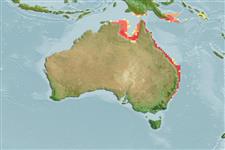>
Syngnathiformes (Pipefishes and seahorses) >
Syngnathidae (Pipefishes and seahorses) > Syngnathinae
Etymology: Hippocampus: Greek, ippos = horse + Greek,kampe = curvature (Ref. 45335); whitei: Name from Latin word for tall, referring to the tall coronet..
More on author: Bleeker.
Environment: milieu / climate zone / depth range / distribution range
Écologie
marin; saumâtre démersal; non migrateur; profondeur 0 - 46 m (Ref. 4281), usually 1 - 25 m (Ref. 30915). Temperate; 20°S - 35°S, 145°E - 160°E
Southwest Pacific: Australia.
Length at first maturity / Taille / Poids / Âge
Maturity: Lm 8.3, range 8 - ? cm
Max length : 13.0 cm OT mâle / non sexé; (Ref. 30915); 11.0 cm OT (female); common length : 8.0 cm TL mâle / non sexé; (Ref. 4281); âge max. reporté: 5 années (Ref. 93066)
Description synthétique
Clés d'identification | Morphologie | Morphométrie
Rayons mous dorsaux (Total) : 17 - 18. This species is distinguished from its congeners by the following set of characters: trunk rings 11; tail rings 34-35; dorsal fin rays 17-18; pectoral fin rays 16; subdorsal rings 3; subdorsal spines 4, superior trunk ridge ending with 3 enlarged spines, the superior tail ridge commencing with one enlarged spine (3/0,1,0); cleithral ring spines 3, one small spine at each end of pectoral-fin base, none at gill-opening, large single or double spine at ventral extent of head; with 2 small lateral head spines, one directly posterior of eye, one anterodorsally of operculum and ventral of coronet; with a distinct snout spine; no parietal spine or diminutive if present; single eye spine, large and protruding dorsally; small single or double spine, rugose, posteroventrally of eye; the coronet, distinct and tall, protruding anteriorly in juveniles, angled
dorsoposteriorly in adults, and with 5 small spines present on apex in a star-like arrangement;
superior trunk with enlarged spines on first and eigth tail ridges (Ref. 125503).
Occur in coastal estuaries and embayments (Ref. 125503); in shallow, weedy inshore areas and Zostera seagrass beds; also on sponges. Also under jetties on holdfasts of kelp, and on other man-made structures such as shark nets. Diurnal and site faithful (Ref. 30915). Female max length (Ref. 42735). Ovoviviparous (Ref. 205). The male carries the eggs in a brood pouch which is found under the tail (Ref. 205). Minimum depth reported taken from Ref. 128812.
Gestation period 21-22 days depending on temperature (Ref. 30915). Monogamous and faithful to pair in the wild (Ref. 30915). Monogamous mating is observed as both obligate and genetic (Ref. 52884). Male carries the eggs in a brood pouch (Ref. 205).
Short, G., D. Harasti and H. Hamilton, 2019. Hippocampus whitei Bleeker, 1855, a senior synonym of the southern Queensland seahorse H. procerus Kuiter, 2001: molecular and morphological evidence (Teleostei, Syngnathidae). ZooKeys 824:109-133. (Ref. 125503)
Statut dans la liste rouge de l'IUCN (Ref. 130435)
Menace pour l'homme
Harmless
Utilisations par l'homme
Pêcheries: intérêt commercial mineur
Outils
Articles particuliers
Télécharger en XML
Sources Internet
Estimates based on models
Preferred temperature (Ref.
123201): 21.7 - 27.1, mean 25.4 °C (based on 146 cells).
Phylogenetic diversity index (Ref.
82804): PD
50 = 0.5000 [Uniqueness, from 0.5 = low to 2.0 = high].
Bayesian length-weight: a=0.00447 (0.00177 - 0.01127), b=3.00 (2.78 - 3.22), in cm total length, based on LWR estimates for this (Sub)family-body shape (Ref.
93245).
Niveau trophique (Ref.
69278): 3.4 ±0.5 se; based on size and trophs of closest relatives
Résilience (Ref.
120179): Milieu, temps minimum de doublement de population : 1,4 à 4,4 années (Assuming annual Fec<1000).
Fishing Vulnerability (Ref.
59153): Low vulnerability (12 of 100).
Nutrients (Ref.
124155): Calcium = 152 [88, 414] mg/100g; Iron = 0.824 [0.417, 1.602] mg/100g; Protein = 17.4 [16.1, 18.8] %; Omega3 = 0.511 [0.228, 1.134] g/100g; Selenium = 17.9 [7.4, 44.4] μg/100g; VitaminA = 8.22 [1.79, 36.79] μg/100g; Zinc = 1.07 [0.68, 1.68] mg/100g (wet weight);
